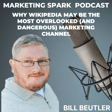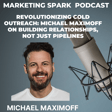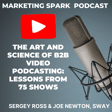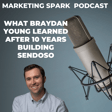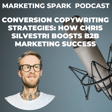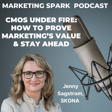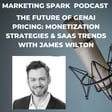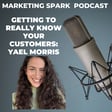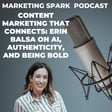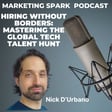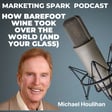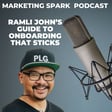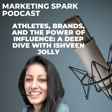Become a Creator today!Start creating today - Share your story with the world!
Start for free
00:00:00
00:00:01

Seeing is Believing: The Impact of Video for B2B SaaS Marketing - Sergey Ross
In this episode, Sergey Ross and I explore the power of video for B2B SaaS companies looking to accelerate their growth.
We talk about how video can be used at every stage of the sales funnel, from initial pitches to product demos and beyond.
We also dive into best practices for creating effective video content, including tips for scripting, filming, and editing.
Whether you're a startup or an established B2B SaaS company, we will give you the tools you need to use video to drive growth and increase conversions.
Join us for an in-depth discussion on how to harness the power of video and take your B2B SaaS business to the next level.
Transcript
Words vs. Video: The Modern Content Shift
00:00:08
Speaker
As a writer and former journalist, I believe that words matter. Words are powerful. They make an impact. They influence, motivate, encourage, enlighten, and entertain. But as much as I love words, I recognize that there's a huge appetite for video within a fast-paced, instant gratification world. Video is easy to consume.
00:00:32
Speaker
It's user friendly and delivers a lot of information within a short amount of time. I mean, who doesn't spend a lot of time watching videos on YouTube, Instagram, and TikTok? And the challenge for many content marketers is turning all their words into videos.
Sway's Mission: Transforming B2B Content
00:00:49
Speaker
Wouldn't it be great if they could magically transform blog posts, guides, and tutorials into videos that inspire, educate, and engage? And what if they could do it at scale and have it optimized for social media?
00:01:02
Speaker
Well, Sergei Ross thinks he's figured out how to tackle this challenge. He recently launched Sway, a media production company that offers video strategy and production for B2B companies. Welcome to Marketing Spark. Great to have you, Mark. Thank you.
00:01:19
Speaker
Love to get into Sway, its origin story, and why you decided to launch the
The Rise of Video in B2B Marketing
00:01:24
Speaker
company. But before we do that, I'd like to get your take on the video landscape. Right now, TikTok is the bell of the ball. People love the format, more than 2 billion users, a platform that is becoming increasingly difficult for B2B and B2B SaaS companies to ignore.
00:01:46
Speaker
Can you provide some context in terms of where we're at with video within the B2B landscape? How important is it? How well are companies using it? And where are we going? What's over the horizon in terms of video and driving?
00:02:02
Speaker
marketing for B2B and B2B SaaS companies? I think we are very early in B2B sense where we are with video. It's probably worth for the audience to look at the video in three different landscapes. One is B2B, another one is B2C, and then you have individual creators.
00:02:19
Speaker
Individual creators have been doing video for a very long time. YouTube started 2009, 2010. They've experimented a lot. Then B2C folks obviously push the ground quite a bit and B2B is more on a conservative end, as we know. But I think we are at the very, very infancy of what B2B can do and what they will be doing in terms of video. What will happen is likely we'll see a lot more companies operating as a media company producing consistent video content as part of a series.
00:02:49
Speaker
There has been a little bit of an uptick with podcasts, but podcasts are mostly audio formats. Some people put them on YouTube, but that was just a sneak peek of what to come. I think what we'll see with B2B is a better produced video series that happened season after season after season of that work in parallel.
00:03:13
Speaker
closely with the written content because companies finally figured out how to do B2B companies, figured out how to do written content. They have great engines, they have calendars, they have guides, they understand for purpose and all that very well. But in terms of video, I think we're yet to hit that tsunami that is coming and that is going to be very exciting.
TikTok and the B2B Marketing Frontier
00:03:33
Speaker
In terms of TikTok,
00:03:35
Speaker
TikTok is a tremendous platform and it could be used for B2B as well. Obviously organic reach, obviously creativity and the fact that how easily people could discover your content is massive. Could this be used for B2B? Probably. Certainly worth at least testing, but a lot depends on the context.
00:03:54
Speaker
What depends on where the company is at? What kind of content they already have? What can they produce? And what developed channels they have? Because if they don't have a developed, they have a developed email channel, and they need results, like we know B2B yesterday, you got to optimize for that email channel, you got to optimize for LinkedIn if they're on it. So there's always that resources and resources are limited. But
00:04:18
Speaker
And then the other point is if, for example, you have limited resources, you also want to be careful in what kind of channels you want to be on at the same time. So there's a few considerations to make there, but TikTok absolutely worth looking at.
Accessibility vs. Barriers in Video Creation
00:04:32
Speaker
One of the questions that I have when it comes to video production is that it has become a lot easier to make videos, edit videos, distribute videos with the iPhone, for example. I mean, you have a
00:04:44
Speaker
beautiful camera in the palm of your hands. You can buy some really good but inexpensive lighting for a hundred, a couple hundred bucks. But when you look at the B2B and B2B-class landscapes, there are companies that stand out as leveraging video. A company like HubSpot, for example, does a great job of video. But I would argue that
00:05:05
Speaker
Those companies are anomalies or content unicorns because they stand out because they're the ones actually doing it and many companies are still leaning hard into words, maybe into podcasts as a sort of almost like a little adjunct to conversations. Video still strikes me as being this
00:05:25
Speaker
platform that a lot of companies aren't leveraging maybe because they don't have the resources, maybe because it's not how their organizations are structured. So what do you think is holding back companies from truly leveraging the power of video?
00:05:39
Speaker
I think there are a few factors. One of the factors is a bad habit that started in certainly B2B of making one-off videos that cost over $5,000, $10,000 per video. And that becomes a norm. And you pair it with the way that how conservative B2B industry is.
00:05:59
Speaker
Then there's a perception that's been made that videos are incredibly expensive. I had to sit down in my office. I had to rent an office. I had to get a guy with a $10,000 camera. That doesn't help. That doesn't help that perception. On the other end also doesn't help. We have Fiverr. We have Upwork. We have people who very recently started offering repurposing services of short clips.
00:06:22
Speaker
They are good. They are better than doing nothing. But they are far. They're not really what video can be. They're not most engaged. They are not native content. They are cheap. They have that advantage. But they don't really work very well. So then another component is marketing leadership and C-level leadership. Marketing leadership, they have certain perceptions. And those perceptions are not easy to change. A lot of times,
00:06:50
Speaker
B2B leadership is conservative. They know what works. They know content works. They know demand gen programs work and video. Maybe we should try it, but then a lot of times they try a few videos. Maybe they do a few webinars and then usually after three or four episodes the project gets killed.
Starting Simple with Video Production
00:07:08
Speaker
So there's this combination of factors that certainly doesn't help and it doesn't also help because
00:07:14
Speaker
the video production companies, most of them majority, probably more than 99%, they are offering traditional video production that is expensive or it could be cheap. So there's no something in the middle that takes inspiration from either media companies or individual creators where you could still take an iPhone, make a video, but you don't need expensive lights, you don't need production people and it doesn't cost you that much.
00:07:41
Speaker
When I deal with my clients, and most of them are organizations under $5 million in sales, they're doing very little marketing or no marketing at all. And I want them to embrace video because I believe in video, even though admittedly I don't use it as much as I should. I need to get back on LinkedIn. I should probably start experimenting with TikTok. When I press them to embrace video, the pushback is production quality. We have to script it. We have to storyboard it. We have to make sure it looks good.
00:08:10
Speaker
And I say, listen, you have to start somewhere. You have to start making videos so that you're actually in the video business. And I look at the way that I make videos. I have a $200 set of lights. I use an iPhone with a nice tripod. And I use Descript, this amazingly
00:08:27
Speaker
Easy user friendly video editing platform and i put videos out there that admittedly are the highest quality in the world like my face is out there i personalized my brand i'm in the video game. And i try to convince my clients this is this is a good approach to experiment i think that one of the things that has become obvious during the pandemic.
00:08:55
Speaker
is that people accept lower standards of video production levels don't have to be high because admittedly we're all working with absolutely in at home i do question the fact that there's such a resistance to just using some simple tools to get going it's a lot to do with the experimentation mark i think it's it's the fear of the unknown uh and and trying and being a little afraid
00:09:17
Speaker
especially if it's when it's paired with results. Sometimes we speak with clients, they say, Oh, what's the ROI on the video? There is no ROI on that video. Nobody could guarantee ROI on the video the same way they can't guarantee ROI on a piece of content. They could guarantee impressions, but that would be done purely with ads. And again, there's a big question mark on where that audience comes from. So you can't guarantee it. And if there's a, if people come
00:09:43
Speaker
to video with that kind of resistance it's going to be harder but what they need to know and why we're talking about video 80% of people want to consume visual content not in a written format they want to watch it the other one which is really important is trust
00:10:00
Speaker
curve because the trust through video is much higher than for words. I guarantee pretty much for any B2B company, they will go on YouTube or Google and look them up at a certain point in a deal cycle. They'll try to look them up and they'll land on that interview or in that picture and that's something they'll watch it.
00:10:18
Speaker
especially when they're a little bit closer to the bottom of the funnel, when they're in a consideration stage where maybe they're about to sign a deal, maybe they've done a few demos, and video really, really helps. Now, how many views that video going to get? Maybe 20. If you sign a 150k deal, that's pretty good. So there's all these considerations that need to happen, and that's one of the reasons why we decided to instead
00:10:43
Speaker
going from the tactic as a company is trying to convert written content to video, we decided, hey, let's talk about B2B video strategy and playbook. Because if that stuff is not there, and most of the time it's not, then it just doesn't make sense to even try because we end up again with a one off few pieces of content, they kind of work, they don't really work. But the big part is they are not synced with marketing campaigns.
Aligning Video with Marketing Strategy
00:11:10
Speaker
or they're not sent to a sales enablement so then there's no distribution in place sales is not using it maybe marketing is not using it so then the video exists on the webinar page under resources maybe they posted on a linkedin page on the company page that got four likes maybe they've shared it with their newsletter but that's not really the type of distribution
00:11:29
Speaker
that is going to get results and we're talking if it's a webinar if it's a podcast 45 minutes relatively boring piece of content and that is not it's good to have it to rank on google sorry to rank on youtube number two engine on search it's great but in terms of optimizing for consumption where you actually going to get results not the best way to do it short clips partially solve that challenge
00:11:53
Speaker
but only partially. What you really want to be thinking is how to natively create videos that are a recap of what you have on a podcast or a recap of what you have in a written video format that also don't cost an insane amount. If you're a company that is not using video or using it in a very light way and you recognize that video has an impact, that it's the way to build trust and credibility,
00:12:22
Speaker
Where do you start strategically? It's one thing to make some videos and post them on YouTube and TikTok and LinkedIn. And that's the shotgun approach to marketing. Just put it out there and hopefully it'll work. But when you're working with clients and you're essentially saying, listen, plan the work and work the plan. What are the steps that a company needs to take to make sure that it has a strategy and a purpose
00:12:49
Speaker
and goals before it even starts making that first video. Of course, of course. The first thing is always good to look at the buyer journey. What does that look like? What does existing marketing funnel look like? What kind of content do you have already existent in your marketing? And the most basic exercise in the world, just look at the top, middle, bottom of the funnel. Again, we know this actually is just the
00:13:12
Speaker
This doesn't actually work in the real world, but it's still good to take a look at that. Another part is to look at what marketing is doing right now. There are certain campaigns that are running, what is coming up in the pipeline. Another one is, what are the key questions the target audience is asking consistently in the conversation on a sales call or marketing team? What does that FAQ look like? What is this question that it's much easier to explain visually rather than explaining a written format?
00:13:42
Speaker
So those questions would help at least to get an idea of where maybe the gaps are and maybe what what material could be better communicated in a video format.
The Role of Explainer Videos in Engagement
00:13:52
Speaker
Let's say you have a top of the funnel article, it gets a lot of hits and it's an external explainer. For example, what is cybersecurity?
00:13:59
Speaker
It's generally a good idea to have it in a video format. If you make a two, three, four minute recap video with a good presenter and put it on that page, that's a pretty good option. Another one is the bottom of the funnel. If you're explaining your product beyond the demo, because most companies will have demo videos, but they're also not the most
00:14:19
Speaker
personalized in the world most of the time because they're outsourced and there's a lot of automation happens there. So looking at the bottom of the funnel and maybe there's something in the middle, but looking at the buyer's journey, looking at existing marketing campaigns and looking at the current marketing funnel,
00:14:35
Speaker
and where people get held up. And if there's something that happens a bit slower, could visual, communicating it visually would be easier? And looking also at the sales team, what kind of, if there's a large sales team, if they're SDRs or AEs, what kind of assets are they sending? And could they maybe send something that is a bit more produced than a video art saying hello, Mark, with a whiteboard? Once you embrace a strategic approach to video,
00:15:06
Speaker
Where do you start? What's the first video you should make and as important, how do you extract as much ROI from it as possible? There's a lot of talk on LinkedIn and other places about repurposing and distribution. And obviously that's one thing that companies need to leverage. So walk me through that first video, whether it's a minute or five minutes or a 45 minute webinar. And then what do I do with it?
00:15:32
Speaker
Yeah, the classic one, the one that would perform the best, would be top of the final video, where you explain the global landscape, the big shift that is happening that leads people to, hopefully, to your company value, to your company punchline. For example, there's a huge change that is happening in cybersecurity. There are more attacks that happen on computers.
00:15:52
Speaker
And that's why we're doing XYZ. And this is how it works. This is how attack happens on the computer. And this is why it's important. Those are top of the funnel videos. A lot of people would like to watch them. There's a chunk of people who would be outside of your ideal customer profile. But that's a good top of the funnel video to start. It's a typical explainer where I would recommend to start. And then you put it on YouTube. You make videos for YouTube shorts.
00:16:19
Speaker
you put them on a verticalized format as well on LinkedIn, you would make them for, you could potentially make them for TikTok, but I would probably optimize them for LinkedIn, YouTube, YouTube Shorts, and email, especially if your sales team will be using them. And the difference between this type of video that I've just described and the videos that are right now being produced is that this is presenter-driven videos. There's a person
00:16:45
Speaker
Ideally, it's somebody in your company who explains the concept, there are things that are happening on the screen, and it's more human than if it's just pure animation of characters and a mega-detached voiceover, which actually costs insane amount and shouldn't. So this is the video that I would recommend people to at least consider at first, because I can guarantee they probably already made an article about it. You don't have to follow it to the tee. Obviously, the video script is going to be different. But in terms of the length,
00:17:11
Speaker
Honestly, two to five minutes would probably be enough. You don't want to make it too long. Just see which points do you want to hit and how dense do you want to make your point because you could make a video in 30 seconds. You could make it in 10 minutes. Generally, two to three minutes is a good length. I'm really glad that you mentioned overview videos.
00:17:32
Speaker
Because when I'm helping companies put together websites, they spend a lot of time on the value proposition and the key benefits and the features that they want to highlight and their customer logos. And there's a tremendous amount of time and effort and money.
00:17:47
Speaker
focused on developing this website that's gonna make this impact. But the one thing I tell them is you need a explainer video and it needs to be on the homepage, embedded in the hero image and or on the about page because a lot of people are lazy. They scan, they don't read, they want instant gratification. And an overview video is a great way to deliver your message really quickly. And then you can obviously use it in other places.
00:18:16
Speaker
When you visit a B2B and B2B SaaS website and you don't see an overview video, what message does it send to you? Obviously, as a videographer, you're going, they should hire me, right? Well, I don't know. But what are they saying? Is it just that they're cutting off their nose despite their face, or they just don't know any better, or they just don't think about it? It's a mystery to me.
00:18:37
Speaker
Yes, it's probably one of the two latter points that you made. They probably maybe are not thinking about video. Maybe they don't have a way to produce the video. But it's also the current landscape of explainer videos is also a bit wrong in a sense that there's this explainer video concept, which is purely animation, that costs a lot, that came up a long time ago, years ago, and everybody still uses it. And there's a lot of animation companies that will hit
00:19:05
Speaker
other b2b leaders on linkedin gladly trying to sell it but that's not what you should be doing what you should be doing is just taking a human approach of explaining it like you're in a in a classroom in a boardroom and just making it simple and as a matter of fact you can make an explainer video that costs significantly less that most companies charge
00:19:25
Speaker
by cutting the expensive video guy and just and the lights, you can get a good ring light that we could actually ship to you. You could use your iPhone. And what really matters is the sound. And then a lot of our bits are easy to add in post production. And I could guarantee if you take that video
00:19:42
Speaker
and then use the typical 8K, 10K video, the perceptual difference will be minimal. And as a matter of fact, you could always argue that a video that is done on the iPhone with no blur background in the back is more authentic. People want to watch that. They don't want to watch this highly produced videos because they've been trained, oh, this is an ad, this is like a... And then the moment the corporate music starts, you're like, uh-oh, we're in trouble. People are already leaving. The retention rate is just going down.
00:20:10
Speaker
It is interesting that you mentioned the fact that animated videos have their day. And now it's, they seem like an anachronism is that they're so passé. And there was a company outside of Toronto that would make animated videos for these large companies and charge them 20, 30, $40,000, which was incredible.
00:20:35
Speaker
And now when I look at a B2B or B2B SaaS company and they use an animated video, if they actually have a video, my immediate impression is this is cheesy. This is so like five years ago. Why are they doing this? And what you're saying is that if you put a real person on the screen and you display, somehow display the product or the benefits, that's a much better approach to build authenticity and trust.
00:21:01
Speaker
Absolutely.
Consistency in Video Production
00:21:02
Speaker
It really comes from the world of creators, the creators on YouTube and people who already get a lot of views. It has authenticity. It could still look reasonably corporate. It's a lot cheaper to make, which means that you could have follow-up videos. You don't win with one video, you win with 10, 15, 30, because any time you're looking at
00:21:24
Speaker
at converting people, at selling people a service. Most of the time, you have 20 to 25 to 30 high quality touches that you need to have with your sales team, your marketing, your CEO, your C-level leadership. So then you need to have those hits. If you have just one video, that's one hit. It's good, but then you want to have a follow-up. And that's when
00:21:44
Speaker
Really important to consider the cost and the resources because if you just make one Yes, you could repurpose it and that's great. But then you also want to consider making more if possible so then it's there's always this question of the cost and making sure that you are you are able to produce videos into the future without But not not just stopping at one or two Many
The Media Company Mindset in B2B
00:22:08
Speaker
years ago. I was a journalist for two of Canada's I
00:22:12
Speaker
major newspapers, and I understand what it's like to work for a media company. So when I see posts on LinkedIn with marketing gurus saying, every company needs to be a media company, my first impression is, whoa, that's a big responsibility. There's a lot of work that goes into being a media company.
00:22:33
Speaker
Even if you have a well oiled marketing machine that is producing content and touching prospects and customers in different parts of the buyer's journey that's a lot of work and effort and all of a sudden. Companies are being asked to turn themselves into media companies.
00:22:53
Speaker
I think that's very daunting for many companies, particularly those that don't have a lot of resources. Interested in getting your take on this whole media company focus.
00:23:04
Speaker
Is it realistic? And what are marketers really saying when they proclaim that companies need to be media companies? Fantastic point, Marc. This is a beautiful point, and you're totally right. No business could be a media company. That's just virtually impossible because of the amount of work that companies need to do, the fact-checking, the research. It's absolutely insane. And as a matter of fact,
00:23:27
Speaker
They wouldn't be in their business. They would be in a media business if they were to do it. I think that this concept comes from the mindset and the mindset of consistently producing content that people want to see, that people want to consume. You can't replicate every aspect of a media company. That would be absolutely insane. But the mindset of having an engine of consistently producing videos with much smaller resources, I think that's really the message that
00:23:57
Speaker
Certainly, we want to communicate, and I think a lot of other marketers on LinkedIn want to convey as well. In a sense, if you don't run marketing as a campaign after campaign, you have a consistent stream of material that comes out regardless of
00:24:14
Speaker
of where you are. And the question is always, how do you do this? If you have a limited team, a lot of times is you need to probably outsource some of it. And a lot of companies do do that. It's one of those things that you have to do, because it's impossible to do it with with a small team, you at least need to have most companies do marketing leader, either they call them a director of marketing or senior marketing manager, especially when they're really small. And that person would coordinate
00:24:42
Speaker
everything and be more of a communicator and strategist and work with external partner. But starting on a small scale, like you've said at the beginning, is always a good idea. Maybe you don't produce 10 pieces of content a week, you produce one or two, and that's already so much better. But it's media mindset is also it's tailored to the customer. It's not about the company. It's about what your readers, what your viewers want to see that somehow connects
00:25:10
Speaker
to your service. So it's also a little bit selfless in that way where we've seen a lot of companies try to create lead magnets and own webinars, try to sell it. This is more of a consumption focused approach with a consistent engine of producing material. That's the way that I would describe it. I do want to ask you about Sway and why it was started.
00:25:37
Speaker
But before that, two other areas to talk about what's your take on what's over the horizon in terms of video?
Future Trends in B2B Video Strategies
00:25:45
Speaker
What do you expect to happen in 2023 and 2024 in terms of how B2B and B2B SaaS companies should be looking at video and embracing video?
00:25:55
Speaker
I think we're going to see more ways how companies repurpose video, more ways, not just short clips from the webinars or short clips from the podcasts. That's been the same for a long time. It's amazing that a lot of creators still say this is the way.
00:26:13
Speaker
Anytime anyone says, this is it, I get nervous because that's just not true. That's just not the way that it works. There's tons of different tactics. There are tons of different methods. There's business context. And so you can't just say one is better than anything else.
00:26:27
Speaker
I think repurposing will be an area where things will change. And we just might this year, certainly in the future beyond 2023, we will see new formats appearing. More companies will be stealing concept from HubSpot and they will find ways to make it more economical. Meaning there will be presenter driven content that right now performs extraordinary well on TikTok and on Instagram.
00:26:52
Speaker
and certainly has been doing like that for a long time on YouTube. Talking had videos. B2B industry doesn't almost have any of them, but if we were to look at the way that videos evolved, typically individual creators have it first, then B2C folks try to steal some of it, mostly by working with influencers, and B2B gets it later. So it's a bit of a trickle-down approach, and I think that's a way to see what's coming in the next couple of years.
Platform-Specific Strategies for Video
00:27:20
Speaker
I want to get your quick takes on a few platforms and how companies should be approaching them and embracing them. Let's start with TikTok. What do you do if you look at TikTok and thinking this is a cool thing? I want to be on it.
00:27:34
Speaker
The easiest one would be to try to create content based off your written content. If you already have written content, it's worth making a few experiments and seeing what kind of results you can get by either converting your written or using your written content and making TikTok short videos about it and putting them and seeing what kind of impressions you can get. The other option would be create a net new videos on TikTok
00:28:01
Speaker
maybe somebody from your sales team, maybe somebody on your marketing, maybe it's your CEO who's pretty good at speaking, creating a few bullet points, and speaking, starting with pain points, starting with FAQ, most asked questions that your customers have. And ideally, you start with the top of the funnel, because those are the general topics that will get you the views, and then the views are necessary to convince people
00:28:24
Speaker
in your company to then produce more of these. And just see what kind of results you can get. It may work, it may not work, but certainly you would get benefits if you were to do the same thing with YouTube Shorts purely because of the search. Because when people search you, those will pop up. What about LinkedIn?
00:28:42
Speaker
With LinkedIn, there are two approaches. There's this new concept that emerged a few years ago, growing your business with personal profiles on LinkedIn. So let's say a few people on your company would be posting from their own profiles and a lot of content comes out from them and they drive a lot of impressions, likes, and comments, and they bring the business, they bring the leads. That's one way to do it.
00:29:07
Speaker
it doesn't necessarily mean that everybody can do it, because it's a big commitment. A lot of time is spent on building it, as we know, because we post there. The more traditional approach is when you are posting things from a company page, from a LinkedIn company page. That's just different. It doesn't mean that it's still worth doing, mostly for the bottom of the funnel, because you don't get a lot of impressions
00:29:31
Speaker
and a lot of likes from it. Most people don't engage with company pages. So with LinkedIn, it's a mix of written content, of short form content. You could be posting memes, you could be posting something that short videos that hopefully you'll start making. And
00:29:49
Speaker
There isn't that much different, I'd say, that you could be doing. It really depends on your approach, whether you want to go from your personal profile, if you have a few people on the company that already do it, or a company page. But in terms of company page, if you want to bring that engagement, it's a very short form content that takes inspiration from Twitter, to be honest.
00:30:12
Speaker
If you look at Twitter, people post a lot of memes. They post a lot of that type of stuff that creates an emotion. If you just repurpose blogs, there's still time and place, but doesn't get a lot of engagement. What about Instagram? It really depends if your customers are there. A lot of B2B companies are not doing much on Instagram. I would say it's worth testing, especially Instagram Reels.
00:30:40
Speaker
I would just probably do Instagram reels. I wouldn't spend too much effort on just the regular Instagram feed. And whatever videos you make for TikTok, we put it back on Instagram reels because there's an organic reach that Instagram gave to people that could work potentially. So that's what I would do.
00:31:01
Speaker
We could probably spend a whole podcast talking about YouTube, but what's your quick take on YouTube and B2B companies? Yeah, I think it's just being there first. First being there, most B2B companies get anywhere from 10 views to about 5,000 to 8,000. 8,000 is usually like at the very peak that you could get in B2B. I think a lot of it is really titles and thumbnails. Beyond the fact that you should be making more engaging content,
00:31:27
Speaker
The titles and thumbnails, that's the first thing that every B2B company needs to optimize because they've got a lot of videos and they could, they could do better. Like for example, companies like drift and a lot of other successful B2B companies have terrible.
00:31:40
Speaker
YouTube, because they're not optimized, because people who work with YouTube don't know how to do the YouTube. So that would be the first thing. Consider doing YouTube shorts as well. Ideally, YouTube shorts, they should be in sync with your TikTok efforts and Instagram efforts. And then also doing research on the titles in the future. So when your new video comes out or a new piece of content comes out, the title is actually searched by
00:32:09
Speaker
searched by somebody on YouTube already, so it already pre-ranked by other creators. So then you're getting a bigger boost instead of just taking the title that your writer came out with, because that good performer on the website might not perform on YouTube.
Sway's Approach to Cost-Effective Video Solutions
00:32:26
Speaker
Finally, finally, talk to me about Sway. Obviously, this is your new company. You're very excited. I saw you announce it on LinkedIn a couple of weeks ago.
00:32:35
Speaker
It's a new approach to video. Give me the 101 on Sway. And is it a solo effort? Do you have a partner? And what's been the reception so far? For sure. So yes, I do have a co-founder, my friend Joseph Newton. He's in the UK. And so we started it together about three months ago. Reception so far has been really good. We've had a lot of conversations.
00:33:00
Speaker
We actually started with with with the offer of taking your top performing written content and converting it into video presenter during video that has that would have great distribution because you already have a content that ranks but what we realized that where we started the conversation is there are no
00:33:21
Speaker
there's no B2B video playbooks. People don't quite understand how should you build a strategy based on your business context, based on your resources. So we pivoted and now we start with building B2B video playbooks for companies. That includes pretty much everything. We'll look at your channels, we'll look at your existing content,
00:33:40
Speaker
We'll look at your sales, we'll look at your marketing, and we'll give you themes, we'll give you topics, frequency, and based on your resources. So we'll take everything into account and make sure that you're first producing video content, you're producing at a cost that makes sense, but you're also using all the advantages that your marketing has already built and your sales is doing. We're looking at your buyer's journey and looking at your funnel. So that's the step number one.
00:34:06
Speaker
and for folks who want us to help in them produce it, we will do that as well. But if they just want to understand what the hell do I do with video, well, we got that. As a matter of fact, we are doing free video audits, just stress testing what companies are doing from a video perspective. Anybody who wants it, there's a link on the website and they could book it and they'll get a good idea of specifically for me, what should I be doing?
00:34:34
Speaker
So that begs the question, where do people find out about you and Sway? Yes, so Sway is very easy. It's useSway.co, and you will see a big button at the center, useSway.co. And for me, you could find me on LinkedIn. Probably the easiest would be just to leave a link. And I don't remember how am I, I think it's Sergey Ross live on LinkedIn, but maybe we'll add like a little link and we'll be happy to connect, of course.
00:35:03
Speaker
Well, thanks, Sergey, for all the great insight about video and how BDB and BDB SaaS should approach it. And thanks to everyone for listening to another episode of Marketing Spark.
00:35:13
Speaker
If you enjoyed the conversation, leave a review, subscribe via Apple Podcasts, Spotify, or your favorite podcast app, and share via social media. To learn more about how I work with B2B SaaS companies as a fractional CMO, strategic advisor, and positioning and messaging consultant, email mark at markevans.ca or connect with me on LinkedIn. I'll talk to you soon.

